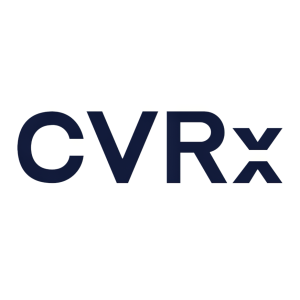CVRx announces availability of additional data supporting long-term benefits of Barostim
- Publication of BeAT-HF trial data in the European Journal of Heart Failure and new abstracts at THT conference showcase long-term benefits of Barostim
- Patients receiving Barostim + GDMT demonstrated sustained symptomatic improvements and reduced risk of advanced heart failure interventions
- Additional post-hoc analyses presented at THT conference further highlight the positive impact of Barostim on quality of life and symptom management
- None.
The publication of the BeAT-HF trial results in the European Journal of Heart Failure represents a significant development in the field of cardiology. Specifically, the sustained benefits of Barostim therapy in patients with heart failure and reduced ejection fraction offer a glimpse into the potential paradigm shift in managing this patient demographic. The reported 34% reduction in all-cause mortality or the need for more invasive procedures such as LVAD implantation or heart transplant is particularly noteworthy. This figure surpasses the thresholds commonly observed in heart failure interventions, suggesting a potentially transformative impact on patient management and healthcare resource utilization.
Furthermore, the improved quality-of-life metrics, such as the MLWHF and EQ-5D scores, align with the increasing emphasis on patient-centered outcomes in medical treatment evaluations. This aspect resonates with healthcare providers and payers alike, as it correlates with patient wellbeing and the potential for reduced long-term healthcare costs. However, it is important to juxtapose these findings with the cost of the Barostim device and the associated therapy to fully assess the economic implications for healthcare systems.
Finally, the reported lack of a statistically significant difference in primary endpoint outcomes such as cardiovascular death and heart failure hospitalization is a double-edged sword. While it underscores the safety profile of the Barostim therapy, it may also raise questions about the degree of its efficacy compared to guideline-directed medical therapy (GDMT) alone for these specific endpoints. Payers and regulatory bodies will likely scrutinize these aspects to determine the value proposition of adopting this therapy widely.
From an investment perspective, the reported long-term benefits of Barostim therapy could be a catalyst for CVRx's stock performance. The medical device sector is keenly observed for such innovations that offer both clinical advancements and potential cost savings. The FDA's expanded labeling, based on these trial results, enhances the commercial viability of the Barostim device. It positions CVRx favorably within a competitive landscape that values proven efficacy and safety, potentially leading to increased adoption rates.
The market will likely respond to whether these trial results can translate into a tangible increase in sales and market penetration for CVRx. Investors should be attentive to further dissemination of these findings among the medical community and subsequent adoption rates in clinical practice. It's also important to monitor how insurance companies and Medicare decide on coverage policies for Barostim therapy, as reimbursement decisions will significantly impact the therapy's market potential.
However, investors must remain vigilant for potential challenges, such as market saturation, competition from pharmaceuticals or other devices and the risk of adverse event reports that can alter a product's trajectory. While the current outlook appears positive, it's imperative to maintain a diversified investment approach, considering the volatile nature of the biotech and medical device industries.
BeAT-HF trial data published in the European Journal of Heart Failure and new abstracts presented at THT conference
MINNEAPOLIS, Minn., April 15, 2024 (GLOBE NEWSWIRE) -- CVRx, Inc. (NASDAQ: CVRX) (“CVRx”), a commercial-stage medical device company, announced today the availability of additional data, including the publication of results of the post-market phase of the BeAT-HF trial in the European Journal of Heart Failure. These data highlight long-term sustained benefits of Barostim in heart failure patients with reduced ejection fraction.
“Publication of these data from the post-market phase of BeAT-HF in this prestigious peer-reviewed journal allows for more effective dissemination of the long-term results of this important trial and the positive symptomatic impact of Barostim on patients with heart failure,” said Kevin Hykes, President and CEO of CVRx. “Additionally, we are pleased at the favorable physician response to new abstracts released at THT in Boston on March 5, 2024, that show a reduction in additional heart failure interventions in patients with Barostim, as well as specific patient-centered benefits at long-term follow-up.”
The manuscript is available online at the European Journal of Heart Failure website. CVRx previously announced some of these data as part of expanded labeling granted by FDA on December 23, 2023. The key benefits of Barostim contained in the manuscript include the following:
- There was not a statistically significant difference in the primary endpoint of CV death and HF hospitalization, demonstrating that the benefits of the therapy do not increase the long-term risk of harm to patients
- Patients receiving Barostim + guideline-directed medical therapy (GDMT) had sustained and significant symptomatic improvements (6 minute hall walk, quality of life and NYHA class) at up to 2 years versus those patients receiving GDMT alone
- Patients receiving Barostim + GDMT had a
34% reduced likelihood of all-cause death or the need for left ventricular assist device (LVAD) implantation or heart transplant, suggesting a favorable effect of Barostim therapy
Additionally, two new post-hoc analyses of the BeAT-HF trial data, presented on March 5, 2024 at Technology in Heart Failure Therapeutics (THT) 2024 in Boston, suggest additional important benefits of Barostim.
- Dr. William Abraham of the Ohio State Wexner College of Medicine presented analysis showing that patients in the trial with Barostim + GDMT had a
74% reduced risk of receiving advanced heart failure interventions (transplant, LVAD, CCM, CRT or CardioMEMS) at long-term follow-up versus patients on GDMT alone. See more details at TCTMD. - Dr. JoAnn Lindenfeld of Vanderbilt University presented analysis showing that patients with Barostim + GDMT had sustained and significant improvements in quality-of-life scores (MLWHF and EQ-5D) and many subdomains of these scores (e.g., reductions in shortness of breath, fatigue, depression and improvements in self-care, mobility and pain, etc.) versus patients on GDMT alone. See more details at TCTMD.
“We are grateful to the BeAT-HF executive steering committee and the many investigators involved in the trial for their dedication to advancing the science supporting this therapy. We look forward to the generation of additional evidence about Barostim from the BeAT-HF trial, as well as from real-world experience through our REBALANCE post-market registry and investigator-initiated research,” said Hykes.
About CVRx, Inc.
CVRx is focused on the development and commercialization of the Barostim™ System, the first medical technology approved by FDA that uses neuromodulation to improve the symptoms of heart failure. Barostim is an implantable device that delivers electrical pulses to baroreceptors located in the wall of the carotid artery. Baroreceptors activate the body’s baroreflex, which in turn triggers an autonomic response to the heart. The therapy is designed to restore balance to the autonomic nervous system and thereby reduce the symptoms of heart failure. Barostim received the FDA Breakthrough Device designation and is FDA-approved for use in heart failure patients in the U.S. It has also received the CE Mark for heart failure and resistant hypertension in the European Economic Area. To learn more about Barostim, visit www.cvrx.com.
Media Contact:
Laura O’Neill
Finn Partners
917.497.2867
laura.oneill@finnpartners.com
Investor Contact:
Mark Klausner or Mike Vallie
ICR Westwicke
443.213.0501
ir@cvrx.com








